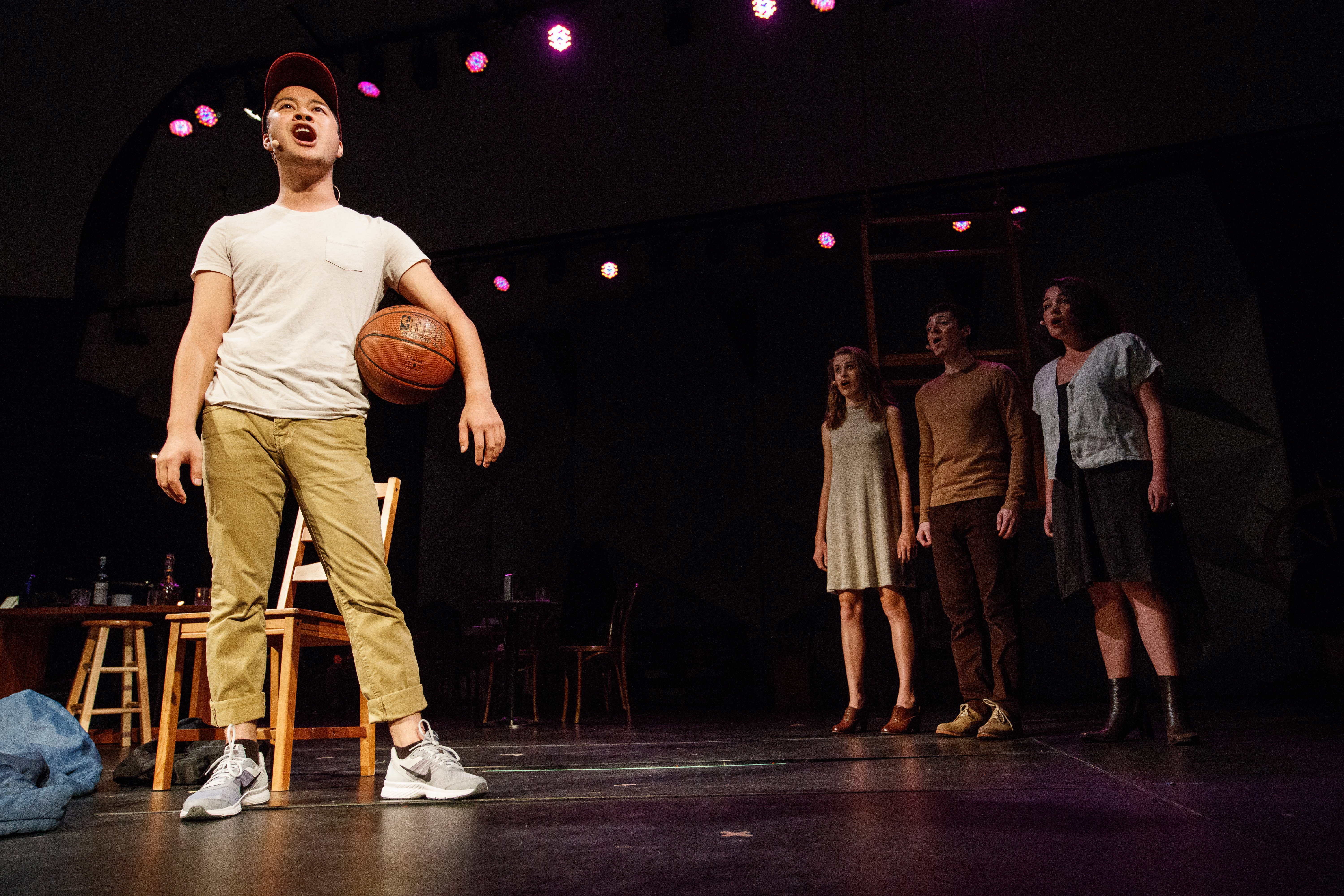“I don’t like to philosophize, I just want to tell a story,” James Seifert ’17 sings in “Songs for a New World,” a joint production between At the Fountain Theatricals and the Stanford Music Department. And the show is filled with stories, beautifully sung by a talented cast, but it’s not always clear why these particular stories are being told.
“Songs” is producer and music director Makulumy Alexander-Hills’ ’16 senior concentration project, and Jason Robert Brown’s intricate score is a worthy challenge. The 1995 song cycle marks Brown’s composing debut, though he is now better known for more recent works “The Last Five Years” and “13.” Though the show exposes some of Brown’s inexperience in terms of structure, the score already displays the ceaseless rhythmic and harmonic experimentation that continues to characterize his work. Alexander-Hills and his five-piece band handle this complexity with ease, as do the singers.
The four performers — Laura Austin ’16, Amy DuBose ’15, David López ’17 and Seifert— are all extremely strong vocalists who navigate Brown’s score deftly. There are moments when their harmonies sound like four competing soloists, but for the most part, they merge, developing a breathtaking four-part musical texture.
López has an incredibly distinctive falsetto range, and this is rightfully featured at many points throughout the show. Unfortunately, his more delicate register is often drowned out by the band, resulting in the inappropriate deflation of tension.
Austin’s soprano soars along the top of the arrangements, and her sweet duet harmonies with Seifert in “I’d Give It All for You” provide the purest moment of human connection in the second act. And it is a pleasure to have DuBose gracing Stanford stages once again — when she teases, “Clearly, I’m not wanted anymore / Now I’m not so young and beautiful,” there’s a nod to the time-honored tradition of Stanford graduates continuing to perform in student theater.
Each song thrusts us into a new scene, with new characters to care about and listen to. Director Elisa Vidales ’18 makes a commendable effort to ground the songs in specific settings by making imaginative use of the collection of sparse, mismatched furniture and costume pieces that make up the set. At the top of the show, it’s hard to discern a connection between the basketball, two Santa hats, picture frame, rope, park bench and assortment of other artifacts which clutter the stage. By the end, the pieces remain separate from one another, retaining an element of randomness, but each also feels deeply familiar, irresistibly linked to character or a resounding moment in the show.
While some of the specified setting decisions add to the power of the show, others feel forced or unclear in a way that truly detracts from the experience. “The River Won’t Flow” works well in a cafe-bar, with Seifert drunk, López bartending and Austin and DuBose gossiping their backup vocals. In another moment, a hair salon, with the built-in audience of hairdresser López, proves the ideal setting for DuBose’s heartbreaking, reflective “Stars and the Moon.” But the sailing ship in the second number is a step too far, as it comes out of nowhere and doesn’t feel justified, while Austin’s beautiful songs are actually disadvantaged by a lack of a distinctive setting. This awkwardness characterizes the show’s strained effort to propel what is essentially a collection of audition songs into a full-scale musical.
It’s hard to know if DuBose and López are more adept at communicating characters than their co-stars or if their parts are just written better for this. Austin and Seifert seem to play endless variations of straight white people, which I suppose could be called continuity, but in actuality, it plays as boring. Even worse, Seifert’s characters are not particularly likable — are we supposed to commiserate when he complains about women crying? Commend his decision to withhold his infidelity from his fiancee? It’s as though these characters are meant to be everymen, but they bear little resemblance to anyone. Instead, you end up identifying with unlikely figures — a Betsy Ross type, for example, or Mrs. Claus.
Interestingly, López was cast in a role written for Billy Porter, a black actor. López displays dynamic range, from righteously frenzied in “King of the World” to tender in “Flying Home,” and his ethnicity is rarely the focus. But there are a few moments — like when the company breaks into what can only be called gospel-style harmonies at the ends of his songs, or when he sings about escaping the cycle of poverty through basketball — when the stage is suddenly conspicuously devoid of melanin. This is not in any way to say that López does not earn this role, but it is disappointing that in a production that’s taking liberties with traditional casting practices, three out of four actors are still white. And if there is nothing saying that López’s role needs to be black, there is even less saying that the other three need be white. It’s an uncomfortable switch and hints at the troubling assumption that actors of color are somehow interchangeable.
And in the end, the decision to forgo a traditional narrative arc has its drawbacks. As Brown describes the show, “It’s about one moment. It’s about hitting the wall and having to make a choice, or take a stand, or turn around and go back.” And while this theme does tie the disparate songs into a cohesive whole, it also denies the chance for any real character or plot development. At times, the show feels like a stuttering reiteration of the same “one moment”; we see the decisions, but none of the aftermath.
Contact Kathleen Kelso at kkelso ‘at’ stanford.edu.
